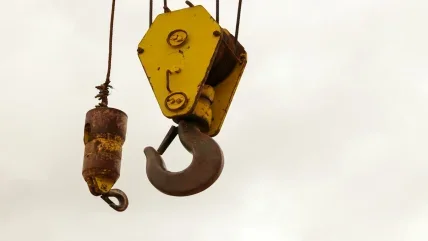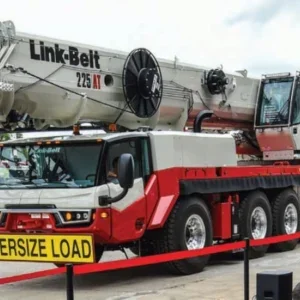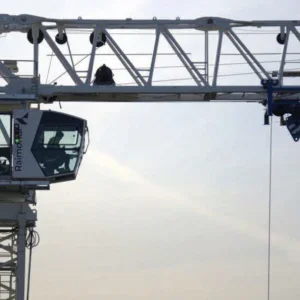
The first camera systems were sold on the basis of enhancing the crane operator’s viewpoint instead of relying solely on two-way radio communications with a spotter on the ground.
The secondary benefits that the systems offered—the ability to record and store video and audio footage—presented the general contractor with a useful method of reviewing and investigating on-site incidents. Construction contractors are continually challenged with reducing risk and liability and many big companies bought into the technology early on.
“The camera system gives crane operators an optimal view of the instructions from the rigger, the lifting hook, the load and the entire surrounding situation.
Operators can lift and release the hook quickly and easily and with complete confidence, making the whole process safer and helping to keep the work on schedule,” says Thieme Wels at Stoneridge- Orlaco.
“We see that loader cranes have developed rapidly over the past few years, with an increasing number of cranes being developed for special purposes. For example, heavy-duty loader cranes are usually equipped with a second articulated arm. This opens up a whole host of new possibilities for the cranes, with some being able to reach heights of up to 57m. These cranes can be used on construction sites to position profiles at great heights or to lift loads above roof height. However, this height means that the operator does not have a good view of the load—vision solutions therefore have a crucial part to play in increasing safety and productivity,” says Wels.
Camera systems are now considered by many to be critical, must-have equipment, a minimum standard which many contractors and even crane operators insist on. The technology fulfils a vital health and safety role.
“Unfortunately there have been a couple of incidents that resulted in fatalities where camera systems were not in operation,” says Peter Hird, managing director of BlokCorp, manufacturer of BlokCam. “The inquiries stated that if cameras were fitted and used the fatalities could have been avoided. Contractors soon started to specify the systems as a minimum standard.”
“We saw ourselves in the safety business but we quickly learned from the industry we were also valued for productivity,” says David Catanzaro, general manager of HookCam. “Yet, we continue to this day to follow our safety mantra: HookCam makes every pick safer. We best do our job if we consider the crane operator is our customer. We provide the operator with a view from the hook just as if he or she had eyes on the hook.”
There are generally two types of camera: jib-mounted and hook-mounted. Jib- or trolley-mounted units are operated by the crane operator, using additional in-cab controls to zoom and pan the image. Hook mounted cameras are simpler as the camera records and displays the scene immediately below the hook and zooms automatically according to the position of the hook, but obviously they only give a localised view of the area immediately adjacent to the working point.
Many crane rental companies offer a crane mounted camera system as part of the contract, either as standard or as an option. Some manufacturers also offer systems as OEM fit.
“We sell directly to OEMs making it possible to integrate our camera systems to cranes. Besides that, we supply dealers, importers and have a worldwide preferred partner network to supply the aftermarket,” says Wels.
But with many camera manufacturers promoting the systems on the basis of ease of installation and versatility, it is not impossible for a contractor to favour and acquire a particular brand or type of system themselves which can be switched between rigs and redeployed to whichever plant is required on-site.
“HoistCam installs in seconds by quickly attaching anywhere with magnets and safety lanyards.
Our systems are very flexible and easy to move around and probably one of the easier in the industry to do so. Riggers have the ability to install and remove portable systems in minutes. The ease of use from moving HoistCam from site to site is dependent on the type of heavy equipment the system is being commissioned on,” says Greg Lanese, VP of sales and marketing for Netarus, manufacturer of the HoistCam system.
“In many cases we receive requests to re-install our HookCams on new sites. It is easily removed and re-deployed. It has three separate wireless sections.
So each section can be removed, and deployed to the new site. We have several systems that are on their fourth and fifth deployment,” says Catanzaro of HookCam. “We just got a HookCam back from Portugal that we updated and sent back. It has been in service at one site for two years. We have another on a Navy project that has been in constant use for nearly seven years.”
What is in the box?
As you would expect with any type of digital technology, the exact specifications vary between manufacturers. Boiled down to its constituent parts a crane mounted camera system will have a housing which can be affixed to the hook or jib, usually by the way of magnets.
The housing will contain a camera lens, a digital sensor to capture the video, a microphone to record audio, a transmitting system to relay the footage to the crane operator and/or off-site archive or monitoring facility and a battery.
Obviously that is a very simplified description, there are myriad variations in specification depending on supplier. The main choices, from a physical perspective, are the quality of video (lens and sensor), transmitting system (network connectivity), IP rating for water and dust protection, battery life and ease of re-charging or replacing batteries and the system used for archiving.
Some companies favour a camera housing that contains every element (apart from monitor and recording facility). Others favour separate housings for the camera, transmitter and other components.
Recorded video specs are simple to understand as they are broadly in line with other consumer gadgets. You will note terms like HD, 720, 1080, referring to the resolution of the camera.
Looking at several of the main systems on offer the specifications range from 800×600 resolution and 4:3 aspect ratio to 1920×1080 (1080p HD). Most systems default to at least 720p resolution (what used to be considered as ‘HD’ for domestic televisions).
Connectivity between installed cameras and recording or monitoring equipment is achieved by built-in Wi-Fi, cellphone networks or radio frequencies.
Densely populated urban areas could be surrounded by signals from other equipment, both domestic and commercial. To overcome this camera systems often have the facility to switch channels or frequencies to limit interference.
“The Stoneridge-Orlaco system includes a compact EMOS Ethernet camera, two Ethernet Wireless Sender Receiver (WiSR) units and an optional tablet. The camera has a fully waterproof housing (IP67 & IP69K), HD picture quality and a live image display. The brand-new WiSR technology enables wireless digital video transfer via Wi-Fi. The receiver is installed near the cab, while the camera and transmitter are mounted at the end of the boom on the trolley. Positioning these components outside the range of moving parts prevents damage and vibrations, ensuring a long operating life while also providing excellent vision of the winch,” says Wels.
“Better reception in highly trafficked areas is a key new development. High density bandwidth areas require special modifications where we must balance resolution, latency, band width, channels, etc. We have several radios that are suited to the various traffic situations,” says Catanzaro of HookCam.
Another consideration is the distance between units (camera and recording device). On more remote construction sites the working area might be located some distance from the site office or location of the recording system. In these situations the use of a signal repeating device may be required.
“We can go up to 1km in a direct line of sight, so we can transmit the footage in any direction up to 1km away. This covers almost every type of construction project we are faced with apart from the taller buildings being built in the Middle East.
But we can also install repeaters to amplify the signal and increase the range if required,” says Hird of BlokCorp. “We also have 5G coverage coming in soon which gives us a better signal and better frame rate for the video. As technology moves on we will certainly move with it.”
Catanzaro of HookCam adds: “Another new feature is a series of product improvements made possible with inclusion of a cell modem. With the modem we can provide remote diagnostics of transmission and signal strength.
If we find a downtown area has congested wireless signals we can change channels; it provides access for remote viewing. This same modem allows use of cloud based technologies for our HookCam Analytics, machine learning and reporting.”
Archive and Analytics
At their inception crane cameras were simple passive systems, used only to provide an extra viewpoint for the operator.
This has been superseded as technological developments have been made and secondary benefits were realised. It is now rare to find a system that does not record the video footage and archive it in some way.
This is useful for site managers and contractors, giving them the ability to review the film covering a certain time period.
There is currently no legislation or requirement, in any market we researched, to store or archive the video footage for a set period of time, so it is purely down to the specifics of the system manufacturer what is offered.
Off-site or cloud based archive facilities are sold as an option by companies like BlokCam, HookCam and HoistCam. The footage is stored on a rolling 30- day basis with older video being automatically wiped and replaced by new video streams. This 30- day timeframe should be more than adequate to evaluate worker incidents, for instance.
After discussing the various options and systems with representatives from different companies for this report, anecdotal evidence suggests that people working around a crane equipped with camera technology seem to do their job more efficiently and are more aware of their surroundings. Contractors on larger construction projects have reported that productivity is increased where cameras are used and fewer incidents of workers tripping and falling are also recorded.
BlokCam states: “According to a university study in the Journal of Construction Engineering and Management, having a camera system installed on a crane can help increase productivity by up to 39% in the blind and 27% in the open as a direct result.
“BlokCam allows an operator’s experience to be maximised and put to use in critical lifts, whilst providing visual and audible information, contextual awareness and aid communication with the banks-man. Imagine driving a car blindfolded while the passenger directs you where to go, when to stop and how fast to move, it would be a difficult, dangerous and stressful task to complete.
Now imagine how much safer and more efficiently the driver can manoeuvre without the blindfold.
The operator can quickly make adjustments required to minimise corrections and overshoots and help improve the productivity.”
However a more quantifiable influence on productivity is provided by the analytical reporting that is now being built-in to some manufacturer’s systems.
As video systems record, transmit and archive the footage companies like HookCam offers a full suite of analytical information which could be of use to the contractor. Catanzaro says: “With no additional equipment, HookCam Analytics identifies the image being picked, reports it by name, records the time, place and aggregates picks by category, time to rig, time to un-rig and log time for each pick. The recording and reporting of this information enables the contractor to establish norms for categories of picks, assign billing and manage functions.
“The increase in crane operating metrics provides management with information never before available. We think contractors will readily accept HookCam Analytics as an important management tool.”
US firm Netarus offers a similar system for its HoistCam system called ‘HoistCam Director Remote Enterprise Software’.
The company says: “This lets you monitor any type of HoistCam equipment, crane, platform from anywhere in the world, whether it be in construction, industrial, or marine sectors, through 3G, 4G, or Wireless Access Point connectivity.
Single, centralised monitoring enables enhanced productivity, better allocation of time and travel resources, and quick solutions of any confusion or problems.
HoistCam also offers full service video analysis including complete job site analysis from logistics tracking to safety and operational support.”
“We’re also working on new technologies that will allow our customers to collect analysed data to more efficiently perform their operations. We can’t be more specific as it’s in development, but it does take our SiteTrax.io platform to the next level,” Lanese says.
As with any digital technology the specifications and abilities of the individual components continue to advance at a startling rate. However, each of the systems offered by the companies we have mentioned are already more than adequate to fulfil the role they were designed for. So while improvements might be made in camera or communications technology, it is the opportunities to expand camera usage to other areas which seem to interest most manufacturers.
“We are seeing expansion into the wind turbine industry where there are HSE directives, implemented in 2019, covering the safety of operatives at risk of injury during installation of a wind turbine. Methods and equipment must be used to minimise risk and cameras are one of the methods favoured by the industry,” says Hird of BlokCorp.
Or even adapting a more flexible design to allow customisation of a system to fit any given project.
“Our systems are often tailored to the site and application. We ask what is the objective for the use of the camera. Then if we need to modify the HookCam to best address the need we make modifications. We have concentrated on direct sales to allow for such customer care, to keep quality high and prices low,” says Catanzaro of HookCam.
An associated range of products is also being developed alongside the camera systems. Not to be used as viewing aids or to record work operations but to use parts of the technology as a more simple and more cost effective warning systems.
“For some of the smaller contractors that don’t require camera footage but still wish to reduce risk whilst also avoiding the expense of a camera system, we can now offer Blok Alert,” says Hird.
“This is where the audible systems come in. Blok Alert is the entry-level system available at roughly a third of the price. It is a wireless system attached to the hook of a crane. The audible system can be fitted to a crane in just a couple of minutes.”
AMCS technologies also manufactures systems that reduce risks at construction sites. Its DCS 60 or DCS 61-S anti-collision systems are universal fit and can adapt to all brands and model of cranes. These can be fitted as a standalone network or to run alongside a camera system.
“We are working with some major crane manufacturers, our zoning and anti-collision systems are offered to their customers and are directly installed in their factories,” a company representative told us.
“Communication between each crane and the systems placed on it is by radio. The devices know the positions (location on the site, high/low crane), jib movement speed and direction of orientation and thus avoid collisions.
“The device calculates in real time and in 3D the distances between each elements of the cranes (including the position of the cabin) as well as the movements speeds. This in order to intervene on the controlled mechanisms to ensure a slowing down then a complete immobilization of the crane at a pre-set distance from the obstacle or an other crane.”
With so many on-site variables affecting the various options and competing systems discussed here. It is not inconceivable that larger contractors may need to utilise crane mounted cameras from more than one company, chosen solely to fit the characteristics of a construction project.






